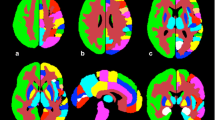Abstract
Introduction
Cerebral blood volume (CBV) measurement by flat panel detector CT (FPCT) in the angiography suite seems to be a promising tool for patient management during endovascular therapies. A steady state of contrast agent distribution is mandatory during acquisition for accurate FPCT CBV assessment. To the best of our knowledge, this was the first time that steady-state parameters were studied in clinical practice.
Methods
Before the CBV study, test injections were performed and analyzed to determine a customized acquisition delay from injection for each patient. Injection protocol consisted in the administration of 72 mL of contrast agent material at the injection rate of 4.0 mL/s followed by a saline flush bolus at the same injection rate. Peripheral or central venous accesses were used depending on their availability. Twenty-four patients were treated for different types of neurovascular diseases. Maximal attenuation, steady-state length, and steady-state delay from injection were derived from the test injections’ time attenuation curves.
Results
With a 15 % threshold from maximum attenuation values, average steady-state duration was less than 10 s. Maximum average steady-state duration with minimal delay variation was obtained with central injection protocols.
Conclusion
With clinically acceptable contrast agent volumes, steady state is a brief condition; thus, fast rotation speed acquisitions are needed. The use of central injections decreases the variability of steady-state’s delay from injection. Further studies are needed to optimize and standardize injection protocols to allow a larger diffusion of the FPCT CBV measurement during endovascular treatments.



Similar content being viewed by others
References
Mordasini P, El-Koussy M, Brekenfeld C et al (2012) Applicability of tableside flat panel detector CT parenchymal cerebral blood volume measurement in neurovascular interventions: preliminary clinical experience. AJNR Am J Neuroradiol 33:154–158
Struffert T, Deuerling-Zheng Y, Engelhorn T et al (2012) Feasibility of cerebral blood volume mapping by flat panel detector CT in the angiography suite: first experience in patients with acute middle cerebral artery occlusions. Am J Neuroradiol 33:618–625
Kim DJ, Krings T (2011) Whole-brain perfusion CT patterns of brain arteriovenous malformations: a pilot study in 18 patients. AJNR Am J Neuroradiol 32:2061–2066
Chiu AHY, Wenderoth J (2012) Cerebral hyperperfusion after flow diversion of large intracranial aneurysms. Journal of neurointerventional surgery
Zellerhoff M, Deuerling-Zheng Y, Strother CM et al (2009) Measurement of cerebral blood volume using angiographic C-arm systems. Proc SPIE 7262:72620H
van der Bom IMJ, Mehra M, Walvick RP, Chueh J-Y, Gounis MJ (2012) Quantitative evaluation of C-arm CT cerebral blood volume in a canine model of ischemic stroke. AJNR Am J Neuroradiol 33:353–358
Yasuda R, Royalty K, Pulfer K, Consigny D, Strother C (2012) C-arm CT measurement of cerebral blood volume using intra-arterial injection of contrast medium: an experimental study in canines. Am J Neuroradiol 33:1696–1701
Struffert T, Deuerling-Zheng Y, Kloska S et al (2010) Flat detector CT in the evaluation of brain parenchyma, intracranial vasculature, and cerebral blood volume: a pilot study in patients with acute symptoms of cerebral ischemia. AJNR Am J Neuroradiol 31:1462–1469
Schaefer PW, Mui K, Kamalian S, Nogueira RG, Gonzalez RG, Lev MH (2009) Avoiding “pseudo-reversibility” of CT-CBV infarct core lesions in acute stroke patients after thrombolytic therapy: the need for algorithmically “delay-corrected” CT perfusion map postprocessing software. Stroke 40:2875–2878
Cademartiri F, van der Lugt A, Luccichenti G, Pavone P, Krestin GP (2002) Parameters affecting bolus geometry in CTA: a review. J Comput Assist Tomogr 26:598–607
Bae KT (2010) Optimization of contrast enhancement in thoracic MDCT. Radiol Clin North Am 48:9–29
Conflict of interest
DR is employed by Philips Healthcare, Netherlands.
Author information
Authors and Affiliations
Corresponding author
Rights and permissions
About this article
Cite this article
Caroff, J., Jittapiromsak, P., Ruijters, D. et al. Use of time attenuation curves to determine steady-state characteristics before C-arm CT measurement of cerebral blood volume. Neuroradiology 56, 245–249 (2014). https://doi.org/10.1007/s00234-014-1321-7
Received:
Accepted:
Published:
Issue Date:
DOI: https://doi.org/10.1007/s00234-014-1321-7




